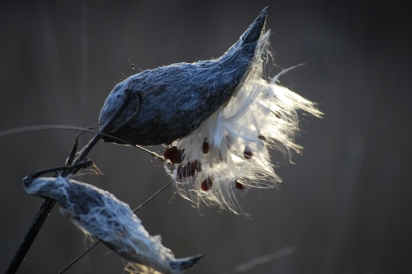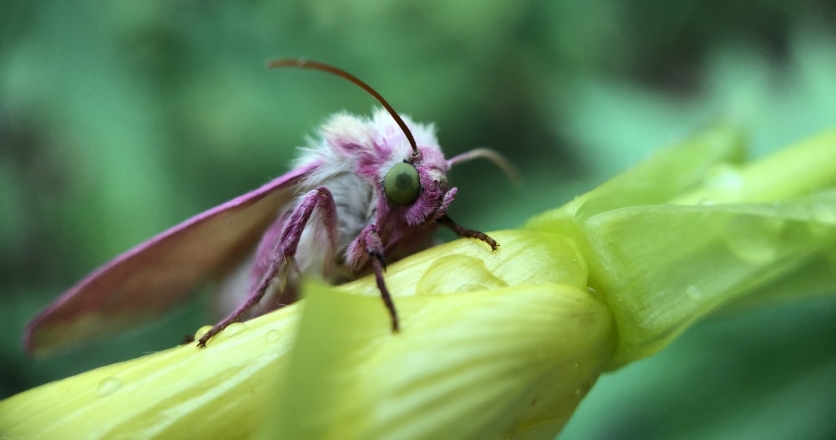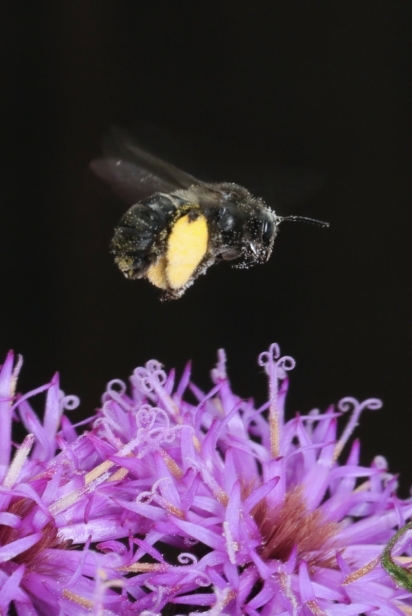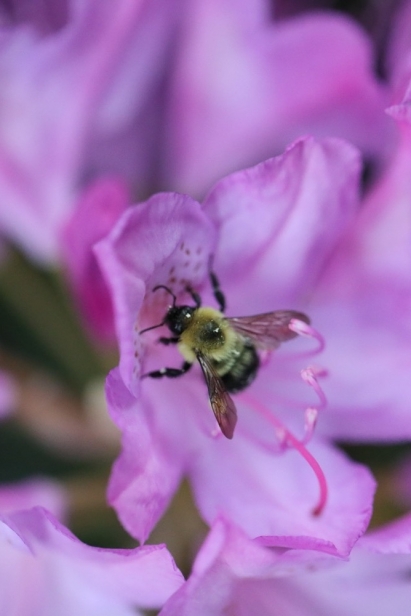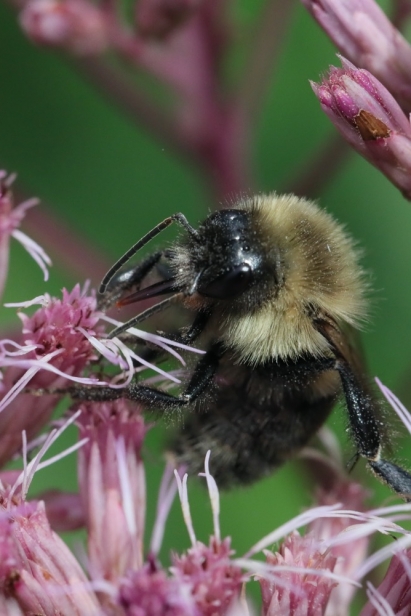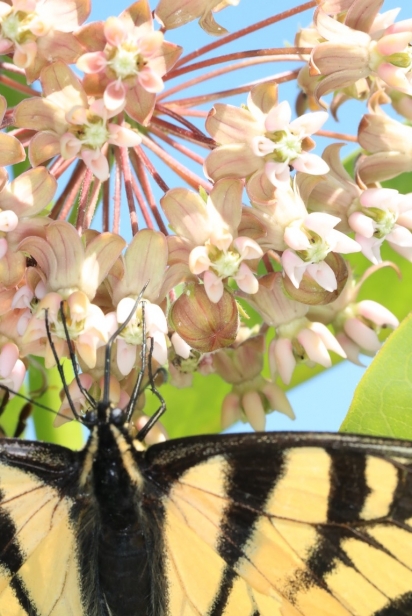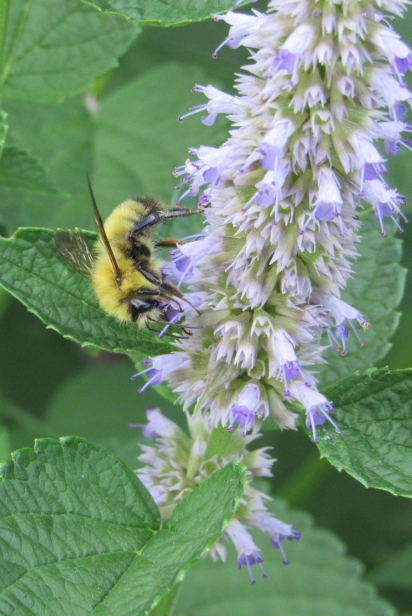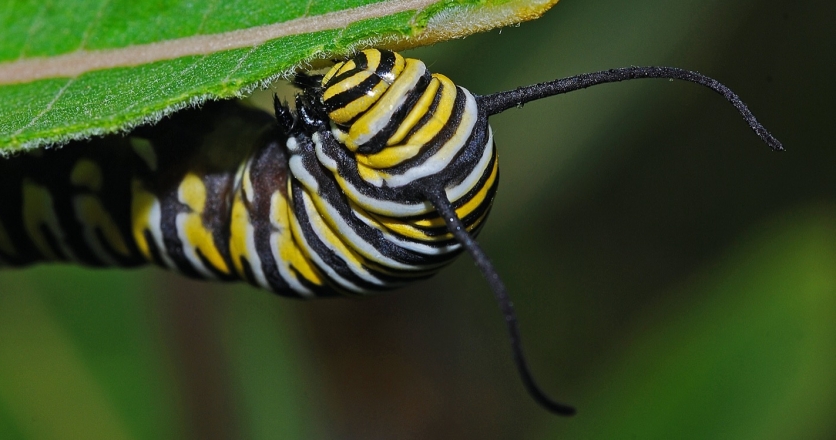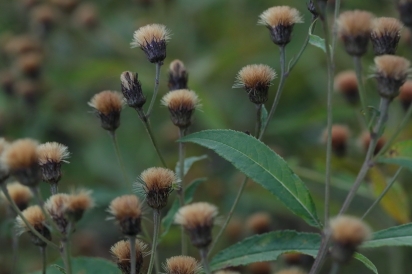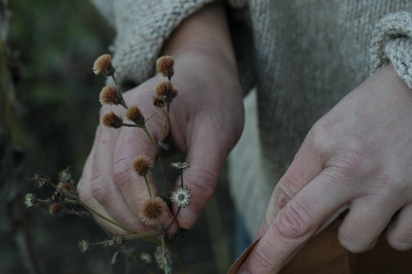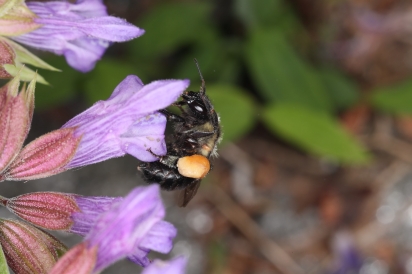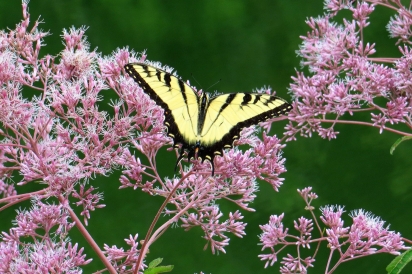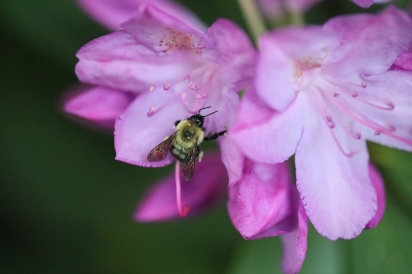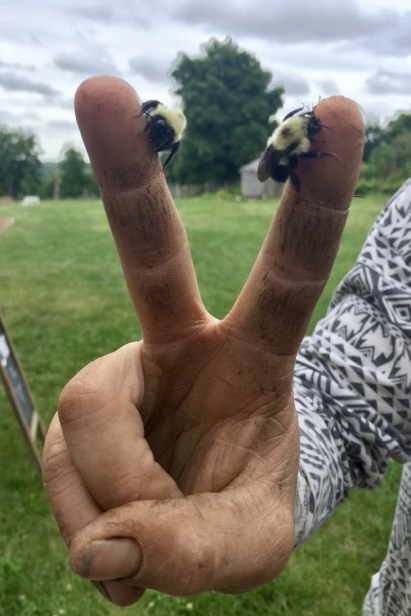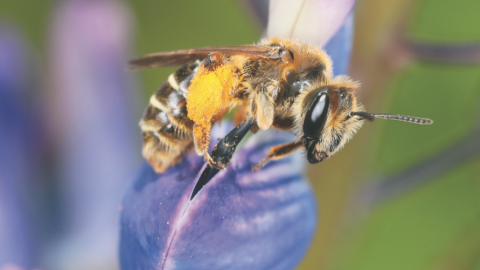The Pollinator Pathway Project
In early winter, the witch hazel outside my front door puts on a wild show of yellow blossoms, indifferent to the knowledge that true spring is, in fact, months and months away. Honeybees are balled up in hibernation; migratory butterflies are snow-birding in the tropics; bumblebees are snuggled in subterranean burrows. It begs the question, for whom is she putting on this show in the dead of winter? Who could love this scraggly little shrub? I watch and wait. The silence of the wintertime morning offers her no suitors.
But there is always someone who loves an oddball, and witch hazel is no exception. Her pageantry is not for me; she sets her cap at the owlet moth, an intrepid wintertime moth that visits the witch hazel in the middle of frozen nights. The owlet moth is specially adapted to take advantage of the freezing temperatures and is uniquely suited to pollinate only witch hazel. To each her own, the saying goes, and when it comes to insects and their niche habitats, you can say that again.
I have farmed for 15 years and gardened for many more. I am intimately aware of how intertwined my life and livelihood is with pollinators. Each tomato, each watermelon, each delicious bite of summertime (not to mention my paycheck) is made possible because an insect visited a bloom, months before. Each seed that passes through my fingers in the greenhouse exists because an insect tended a chosen flower into motherhood. The depth and complexity of the ecosystem that surrounds us is a long, unbroken chain of relationships between insects and plants – carefully developed over countless generations, built and balanced, interdependent layer upon layer. And it is this delicate puzzle that, often innocently, we have begun to pick apart, pulling one piece and then another from its framework. If we mow down the roadside witch hazel, we unwittingly deprive the owlet moth of its food, and without the owlet to carry its pollen, so too is lost the witch hazel. Milkweed must have her monarch, and each sweet, little blueberry must have her bumblebee.
As a farmer, I am dependent on pollination cycles – at least in terms of domesticated crops – but my understanding of the much greater scope they encompass first began five years ago, when I heard Doug Tallamy’s lectures on insects, “the little things on which we all depend.” I learned that my precious farm crops are merely the passing fancy of our Connecticut pollinators, en route to meet their true loves: the last remaining native weeds, trees, and shrubs located in hedgerows and forest outside my trimmed fence lines. The life cycle of every insect requires its host-plant – the plant that insect’s ancestors chose as a partner many millennia ago and with whom they now share one destiny. Tallamy’s equation is simple; to protect the pollinators, we must plant more native plants. The reason we must do so is familiar: mutualism. The food we eat and the air we breathe exists thanks to the complex relationship of services provided by each piece of nature’s puzzle; our needs and nature’s needs are mutual.
Anyone who stands, midsummer, amid the din of bumblebees in a tomato field can see and hear our reliance on the wild things that work in unsung service around us. In the background, we hear the news that Connecticut’s wild bee species are facing habitat losses that are driving many of them to extinction. A 2014 study in Science found a 45% global mean abundance decline in insect populations, and a report published last year in the Biological Conservation journal concluded that over 40% of insect species are currently threatened with extinction. Some reports out of Europe put forward even more alarming numbers. As discouraging as these statistics are, they take on still greater import in light of the indispensable role that wild pollinators play in our food cycle; some studies suggest that as much as a third of our crops come to fruition thanks to pollination by wild insects. (A large portion of the remainder is handled by the honeybee, a domesticated, European species of bee that was brought to North America centuries ago, and which is also at risk of population collapse.) No matter how sophisticated our farming operations become, there is no technology that can outcompete our wild, native pollinators, including the fuzzy, little bumblebee.
The Pollinator Pathway Project
This inseparable twining of farm and forest is the basis of conservation agriculture, and it is the force that drove me off my farm for the first time in 15 years to seek out others who share my emerging passion. I joined the staff at the Northeast Organic Farming Association of Connecticut (CT NOFA) to work on the future of farming in our region and, in that role, was led to Louise Washer, Mary Ellen Lemay, and the Pollinator Pathway project.
The Pollinator Pathway project, covering parts of Connecticut and New York, is a regional extension of an idea that first arose in Seattle. Washer and Lemay have been instrumental in driving the project’s goal: to establish pollinator-friendly habitats and food sources for bees, butterflies, hummingbirds, and other pollinating insects and wildlife. The “pathway” is formed through the establishment of a pesticide-free, semi-contiguous corridor of public and private properties that provide native plant habitat and nutrition for pollinators. This corridor operates as a sanctuary for native pollinators, supplying them with a route to traverse our urban and suburban environments that are often otherwise hostile to them, desert-like and bereft of food and habitat.
In order to accomplish this, Washer and Lemay have helped to rally grassroots organizations, like local garden clubs, land trusts, and nature centers, to identify land within townships that is suited to the task of establishing native-pollinator-friendly habitat. In turn, these organizations help mobilize their members’ communities to spread the word and do the work of planting and maintaining these environments.
Their approach is working. Washer, Lemay, and a volunteer steering committee have captained this pathway as it spread from two Connecticut towns in 2017 to over 85 towns in 2020. Having been in the sustainable-anything-and-everything community in Connecticut for years, I have never seen a movement catch on like this. With each month that goes by, the message of the Pollinator Pathway pours across our state – transforming the landscape, but equally importantly, transforming the minds and hearts of those it touches. Its success is, after all, deeply rooted in active participation by public citizens, willing not only to encourage others to get involved, but also to put their own yards and gardens to use as critical segments of the pathway.
Although the Pollinator Pathway has had great success, it has not done so without its share of hurdles. It turns out that not just any wild plant will do; what’s best are Northeastern native plants: the plants that are truly and originally from here and that stand the greatest chance of being both appropriate and persistent – two things that pollinators desperately need as we hurl ourselves into an increasingly uncertain environmental future. These plants are called “ecotypes” – the species of pollinator plants uniquely suited to our ecoregion (an area that includes most of southern New England). Local ecotypes are the crème de la crème of wilderness, and as such, they should be the foundation of any habitat restoration effort. It’s not just about planting any old milkweed for the monarchs; it’s about planting milkweed from seed that evolved here, in our ecoregion.
Building and curating this living seed bank has barely begun in the Northeast, so the vast majority of the milkweed available to buy in Connecticut is grown from seed produced in the distant Midwest. It was clear to the team at the Pollinator Pathway that their work would rely on getting local ecotype plants into production, first, then into the landscape, second. In order to accomplish this, a partnership between the Pollinator Pathway and CT NOFA was formed.
CT NOFA fosters the organic movement throughout Connecticut, but it is also the table at which all who care about the future of agriculture and ecology can sit down. Bringing local ecotypes of Connecticut’s native plants back into production entails mobilizing a chain of farmers, nurserymen, landscapers, and conservationists who will see them safely nestled across our state. CT NOFA’s alliances across these various industries make it uniquely suited to bring them together in pursuit of a common goal; thus was launched the Pollinator Pathway’s sister program, the Ecotype Project.
The Ecotype Project
The first link in the Ecotype Project chain are our botanists. Conservationists and wild seed foragers gather Connecticut ecotypes of native plants from the few remaining untouched wildernesses of our state. Geordie Elkins from Highstead Arboretum championed the effort in the 2019 pilot season. Using careful protocols for wild collection, he gathered the “foundation” seed of milkweeds, wild bergamot, mountain mint, and several other pollinator-critical species. Aubree Keurajian, of Ungardening, collected a strong crop of goldenrods in the wilds of Durham, and Earthtones Native Plant Nursery in Woodbury offered up some of their precious yarrow.
These plants then go to farmers, a brave handful of whom have established “founder plots” to grow out the wild seed as a crop from which to amplify seed production. These plots have the immediate benefit of creating active, wild pollinator habitat on the farms on which they are planted, but their true purpose is to help stockpile wild seed supplies. For instance, from 200 seeds sown in a founder plot of local ecotype ‘Joe Pye’ (a wild, flowering plant in the sunflower family), farmer Jean Linville has harvested hundreds of thousands of seeds. Much of this work has been aided by a local ecotype warrior, aptly known as “the seed huntress,” Sefra Alexandra. She is probably best known for her efforts to revive Connecticut’s Southport globe onion, but her interests encompass more than just that ancestral crop. Armed with tough hands, an easy smile, and a profound commitment to seed sovereignty, Alexandra stands at the heart of the Ecotype Project, offering support to farmers and monitoring each step of the native seed harvest, then painstakingly cleaning and sifting, counting and weighing, and carefully storing and dispensing seeds.
The recipients of many of these seeds – and the next link in the Ecotype Project chain – are the nurserymen. Before native plants can find their way to Pollinator Pathway locations, someone must grow and prepare the seedlings. Agricultural high schools are doing their part, as are garden clubs and other organizations, but Connecticut’s nursery industry remains central to scaling up production. Darryl Newman is a second-generation Connecticut grower who runs Planter’s Choice, a wholesale nursery and farm with locations in Newtown and Watertown. He and native plant expert, John Campanelli, have set out to grow the seedlings for sale, threading the proverbial eye of the needle that exists as a space to make a real business out of saving the planet. Planter’s Choice is the project’s flagship nursery, and Darryl has been a thought leader in how to maximize production and minimize cost to the consumer. This spring, they will be selling flats of the first Ecotype Project seedlings to landscapers in Connecticut.
You, Me, and Everyone You Know
Which brings us to the last, and perhaps most critical, link in the chain: you and everyone you know. Sowing the Connecticut landscape with these keystone plants to support pollinators is the work that lies ahead. With these plants, we can rewild our land and protect our food supply, we can restore the resilience that nature intended, and we can build a Pollinator Pathway to knit together fragile parcels of precious wilderness and farmland.
Truly, the success of this project comes down to involvement by you, me, and all our neighbors. 85% of the land east of the Mississippi is privately held – most of it yards – but all those yards, strung together, can form a sustaining corridor for native insects, as they move from place to place. By taking time to rethink our lawns and grow native plants, each of us can play a small but critical part in restoring the puzzle pieces of our natural ecosystem that have gone missing.
Washer and Lemay's success remind us that every citizen has the capacity to be a land steward, and every homeowner can be a park ranger over their residential domain. Stewardship is not just for land trusts, conservation is not just for geared-up hikers, and farming is not just for farmers.
The Ecotype Project and Pollinator Pathway are built on the notion that we’re all in this together. Perhaps your town already has organized around supporting the pathway – you can visit Pollinator-Pathway.org to find out and get involved with your town’s group – but if it hasn’t, you and your neighbors are the very people who can initiate it. Involvement can be as simple as making small changes to your yard and gardening plans this spring, or as active as a community leadership role that spearheads the improvement of pollinator habitat across your town through organized events, planting and construction projects, promotion and publicity for the pathway, and more. CT NOFA provides organic land care strategies for gardeners and farmers of any scale.
You are not alone. There is a community around you of people, of pollinators, of farmers, of PhDs, of seed hunters and birders. We are, together, rediscovering our own vital form of mutualism. What binds the Pollinator Pathway and the Ecotype Project is an awakening to conservation agriculture in all citizens. From dooryards to rolling pastures, the private and public lands in our community can be sanctuaries, landscapes that nourish and protect not just courageous bumblebees and owlet moths, but also you and me.
> The Pollinator Pathway Project: 877-679-2463
> The Ecotype Project & CT NOFA: 203-408-6819






